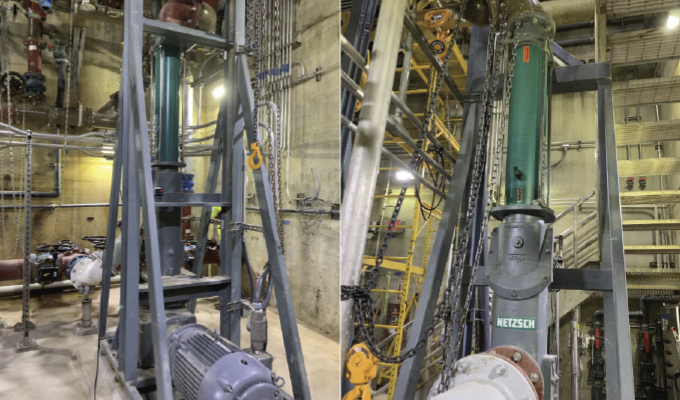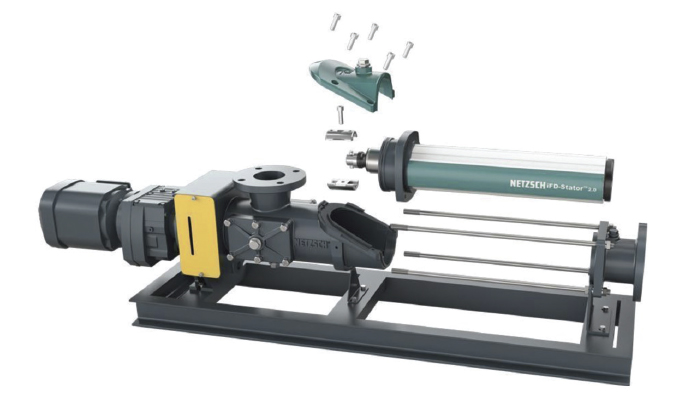Read Part 1 here.
In the first part of this series, we explored how pump configuration options can contribute to cost reductions or minimize maintenance. Now, we wrap up by diving deep into the various materials of construction compatibility as well as concerns over solids handling and fluid media size. Overall, as you examine the varied serviceability options, you’ll recognize the importance of optimizing pump design for cost-efficiency and longevity in wastewater treatment.
MATERIALS OF CONSTRUCTION COMPATIBILITY
Are important to ensure long life, abrasion resistance, temperature, and resistance to upset conditions. For example, consider the following:
Polymers, neat vs blended: Neat polymer requires a specific construction to ensure the rubber does not swell (swelling causes excessive compression and premature failure). This typically requires FKM/FPM elastomers with 316SS construction. Whereas made-down polymer can use Buna and carbon steel.
Ethylene propylene diene terpolymer (EPDM) avoidance:EPDM is not compatible with oils. This should not be used for typical municipal sludge.
Corrosion: This is normally seen as a chemical attack. It can be an acidic or a base. It eats away at the material or can cause swelling or detrition of the materials, resulting in premature failure.
Hardness: This attribute helps to promote long life. Typically, the harder the materials for rotors, the longer they will last. However, the same cannot be said for stators. Sometimes having a softer stator (<60 Shore A durometer), can extend life when pumping very abrasive particles.
Temperature:Temperature can cause the elastomers to expand resulting in excessive compression or on the opposite side, shrinkage due to the cold. This will reduce compression of the stator on the rotor resulting in more slip, lower flow or inability to pump against the backpressure of the system. With freezing temperatures, if the fluid is frozen, cast iron castings could crack.
Adding rotor coatings for increased hardness: Tungsten carbide coatings will make the rotor last 3 to 4 times longer. Re-chroming to add a new layer to the worn rotor is another option and while it is significantly less costly than the rotor coating, it is not recommended. Re-chroming may add a new layer, but the plating is not equally deposited and does not renew to factory tolerances. It also creates high points or low points to the rotor diameter; it does not restore the original diameter. This reduces stator life and may affect pump performance.
Percent solids: determines how fast the pump can run and impacts pump configuration. It ultimately dictates the viscosity of the fluid being pumped. Water like sludges (2% or less), present few limitations on a pump design. However, as the percentage increases, so do the design considerations, such as: mechanical seal, max rpm, motor size, wear resistance, geometry configuration, suction pressure, piping layout, and ancillary equipment.
Fluid media size:Every pump has a maximum particle size it can handle. When it comes to PC pumps, there are two considerations: particle size and max “ball size”. The particle size relates to the amount of particles and average size of particles in the fluid. The max ball size is the largest soft size particle the pump can handle which is typically 80% of the rotor diameter.
Type of shaft seal and seal water/flushing options:This is always a highly debated topic of conversation. With many options, multiple seal manufacturers, and a wide range of applications, each fluid being pumped has certain requirements, each with pros and cons. Depending on the application the design may require packing, single component seal, cartridge seal, double seal, or some new style of seal. It is best to consult with seal and pump manufacturers for the best solution for your process.
There are a variety of shaft seals for different applications and care must be taken to get the right one for the application. Depending on the seal there may be a complex seal plan that must deliver water or fluid to the seal to ensure it operates properly. Otherwise, operators run the risk of the added expense associated with maintenance to pull the pump apart to get access to the seal—the last piece in the pump. Here are some examples that may not fit every application: wastewater to thin sludges (<6 percent) with or without quench or flush could use single slurry seals with a knife edge, encapsulated component, or a standard single mechanical seal, either a cartridge or component. Thick sludges (6 to 10 percent) with quench and/or flush can use single slurry seals, single inverted slurry seal, double mechanical seals, or packing. Cake calls for packing, double seals (>10 percent) with quench and/or flush, double mechanical, or packing. Neat polymer or made-down/mixed emulsion polymer should use single slurry seals, standard single mechanical seals, or packing, while made-down/mixed/emulsion polymer should opt for single slurry seals or standard single mechanical seals.

Correct joint type for application along with the right joint options:The joint to be used depends on the pump size, loading, and operation. For smaller pumps, pin joints are adequate. Pin joint longevity can be increased, however, with a double sealed joint option or the covered seal joint option which protects against abrasion and sharp objects but, for larger pumps, additional joint options are available.
Pumps that will operate with many stops and starts may function more effectively with a gear joint. Double sealed, oil filled gear joints are preferable to those using grease; oil refills and replenishes itself, whereas grease, once pushed out, does not replenish. This makes for a more robust, long life joint, that will tolerate frequent stops and starts (>3-4 starts/hour).
Joint angularity: This is the distance between the joints. Increased joint distance provides a longer joint life. Three forces impact joints: axial (X), shear/bending (Y), and rotational (torque). Higher angularity (Y-axis forces) means less joint life. While you do not want too long a pump, one with a longer joint distance will last longer.
Suction lift requirements: It is common to have suction life requirements for WWTP applications. PC pumps work great for suction lift. However, there are some tricks for ensuring the pump is set up correctly to perform as intended. Having the wrong setup can cause the pump to not work properly or to fail. Consult with your pump manufacturer on their recommendations for suction lift.
Pump orientation: The pump orientation can make all the difference for operational longevity, space saving or for simplifying the piping layout. PC pumps can be positioned in many ways. With PC pumps being inherently long due to the design, it is possible and becoming more prevalent to install them vertically as older plants make upgrades with limited room in the existing buildings. This saves space and preserves the benefits and capability of using a PC pump.

PUMP SERVICEABILITY
Most pump manufacturers offer a full service-in-place (FSIP) option without needing any additional footprint in the often space-constrained process line. In this case the rotor, stator, and mechanical seal can be removed without the need to remove suction or discharge piping, drive, or electrical components. Some can even upgrade existing installed pumps; however, flow and pressure reductions may apply. This can be a time saving alternative to standard servicing, which may require removing piping to get the space needed to service the pumps, as well as unbolting numerous components to take the stator off, and even calling in an electrician to remove electrical components to access the pump for servicing.
PIPING SYSTEMS AND ACCESSORIES
The system design should consider these piping system factors:
- Suction side liquid trap for priming
- Large pipe inner dimensions (IDs) to reduce friction losses
- Long Radius Elbows
- Reduce suction and discharge pipe lengths as much as possible
- A discharge check valve
- Expansion joints
- Avoid pipe stress on pump
- Some form of pressure relief, for example a pressure relief valve (PRV), pressure switch, or burst disc
PUMP PROTECTION
Pump design should include consideration of stator dry run protection, choice of motor thermostats, flowmeter, variable frequency drive (VFD) or over-current. The pump should be designed to avoid cavitation and should include pressure gauges for suction and discharge and isolation from process fluid.
CONCLUSION
The design of progressing cavity pumps plays a crucial role in controlling maintenance costs and extending product life in wastewater treatment plant applications. By carefully considering key design elements such as speed, drive configuration, sealing options, joint types, and piping systems, operators can make informed decisions that contribute to cost reductions and minimize downtime. Additionally, selecting the right equipment and implementing money-saving strategies post-installation can further enhance the efficiency and longevity of pump systems. Ultimately, a well-thought-out design approach not only benefits the immediate operation but also ensures long-term cost-effectiveness and reliability in wastewater treatment processes.
Jeffrey Bye is municipal director for Netzsch Pumps USA. The Netzsch Group is an owner-managed, international technology company with headquarters in Germany. The Netzsch business units Analyzing & Testing, Grinding & Dispersing, and Pumps & Systems represent customized solutions at the highest level. More than 4,000 employees in thirty-six countries and a worldwide sales and service network ensure customer proximity and competent service. For more information, visit www.netzsch.com.


